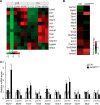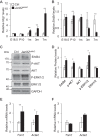Myocardial-specific ablation of Jumonji and AT-rich interaction domain-containing 2 (Jarid2) leads to dilated cardiomyopathy in mice
- PMID: 30700554
- PMCID: PMC6442036
- DOI: 10.1074/jbc.RA118.005634
Myocardial-specific ablation of Jumonji and AT-rich interaction domain-containing 2 (Jarid2) leads to dilated cardiomyopathy in mice
Abstract
Cardiomyopathy is a common myocardial disease that can lead to sudden death. However, molecular mechanisms underlying cardiomyopathy remain unclear. Jumonji and AT-rich interaction domain-containing 2 (Jarid2) is necessary for embryonic heart development, but functions of Jarid2 after birth remain to be elucidated. Here, we report that myocardial-specific deletion of Jarid2 using αMHC::Cre mice (Jarid2αMHC) causes dilated cardiomyopathy (DCM) and premature death 6-9 months after birth. To determine functions of Jarid2 in the adult heart and DCM, we analyzed gene expression in the heart at postnatal day (p)10 (neonatal) and 7 months (DCM). Pathway analyses revealed that dysregulated genes in Jarid2αMHC hearts at p10, prior to cardiomyopathy, represented heart development and muscle contraction pathways. At 7 months, down-regulated genes in Jarid2αMHC hearts were enriched in metabolic process and ion channel activity pathways and up-regulated genes in extracellular matrix components. In normal hearts, expression levels of contractile genes were increased from p10 to 7 months but were not sufficiently increased in Jarid2αMHC hearts. Moreover, Jarid2 was also necessary to repress fetal contractile genes such as TroponinI1, slow skeletal type (Tnni1) and Actin alpha 2, smooth muscle (Acta2) in neonatal stages through ErbB2-receptor tyrosine kinase 4 (ErbB4) signaling. Interestingly, Ankyrin repeat domain 1 (Ankrd1) and Neuregulin 1 (Nrg1), whose expression levels are known to be increased in the failing heart, were already elevated in Jarid2αMHC hearts within 1 month of birth. Thus, we demonstrate that ablation of Jarid2 in cardiomyocytes results in DCM and suggest that Jarid2 plays important roles in cardiomyocyte maturation during neonatal stages.
Keywords: Cardiomyocyte maturation; Dilated cardiomyopathy; Jarid2; Jumonji family; cardiomyocyte; cardiomyopathy; gene expression; gene regulation; heart failure; muscle contraction.
© 2019 Cho et al.
Conflict of interest statement
The authors declare that they have no conflicts of interest with the contents of this article
Figures









Similar articles
-
Cardiac-specific developmental and epigenetic functions of Jarid2 during embryonic development.J Biol Chem. 2018 Jul 27;293(30):11659-11673. doi: 10.1074/jbc.RA118.002482. Epub 2018 Jun 11. J Biol Chem. 2018. PMID: 29891551 Free PMC article.
-
Cardiomyocyte-Specific Ablation of Med1 Subunit of the Mediator Complex Causes Lethal Dilated Cardiomyopathy in Mice.PLoS One. 2016 Aug 22;11(8):e0160755. doi: 10.1371/journal.pone.0160755. eCollection 2016. PLoS One. 2016. PMID: 27548259 Free PMC article.
-
Development of dilated cardiomyopathy and impaired calcium homeostasis with cardiac-specific deletion of ESRRβ.Am J Physiol Heart Circ Physiol. 2017 Apr 1;312(4):H662-H671. doi: 10.1152/ajpheart.00446.2016. Epub 2017 Jan 27. Am J Physiol Heart Circ Physiol. 2017. PMID: 28130335 Free PMC article.
-
Impaired Cardiomyocyte Maturation Leading to DCM: A Case Report and Literature Review.Medicina (Kaunas). 2023 Jun 16;59(6):1158. doi: 10.3390/medicina59061158. Medicina (Kaunas). 2023. PMID: 37374362 Free PMC article. Review.
-
ErbB/integrin signaling interactions in regulation of myocardial cell-cell and cell-matrix interactions.Biochim Biophys Acta. 2013 Apr;1833(4):909-16. doi: 10.1016/j.bbamcr.2012.12.007. Epub 2012 Dec 20. Biochim Biophys Acta. 2013. PMID: 23261977 Free PMC article. Review.
Cited by
-
IRX2 regulates angiotensin II-induced cardiac fibrosis by transcriptionally activating EGR1 in male mice.Nat Commun. 2023 Aug 16;14(1):4967. doi: 10.1038/s41467-023-40639-6. Nat Commun. 2023. PMID: 37587150 Free PMC article.
-
Cardiac-Specific Expression of Cre Recombinase Leads to Age-Related Cardiac Dysfunction Associated with Tumor-like Growth of Atrial Cardiomyocyte and Ventricular Fibrosis and Ferroptosis.Int J Mol Sci. 2023 Feb 4;24(4):3094. doi: 10.3390/ijms24043094. Int J Mol Sci. 2023. PMID: 36834504 Free PMC article.
-
KDM8 epigenetically controls cardiac metabolism to prevent initiation of dilated cardiomyopathy.Nat Cardiovasc Res. 2023;2(2):174-191. doi: 10.1038/s44161-023-00214-0. Epub 2023 Feb 13. Nat Cardiovasc Res. 2023. PMID: 38665902 Free PMC article.
References
-
- Ujfalusi Z., Vera C. D., Mijailovich S. M., Svicevic M., Yu E. C., Kawana M., Ruppel K. M., Spudich J. A., Geeves M. A., and Leinwand L. A. (2018) Dilated cardiomyopathy myosin mutants have reduced force-generating capacity. J. Biol. Chem. 293, 9017–9029 10.1074/jbc.RA118.001938 - DOI - PMC - PubMed
Publication types
MeSH terms
Substances
Grants and funding
LinkOut - more resources
Full Text Sources
Molecular Biology Databases
Research Materials
Miscellaneous

